Determination of Cr (VI) in Drinking Water, Ground Water and Surface Water by Ion Chromatography as per U.S. EPA Method 218.7
Chromium is one of the essential micronutrients required by living cells to convert fat into energy. While Cr (III) compounds pose no major risk for humans, the strong oxidizing agent hexavalent chromium – Cr (VI) – is classified as a poisonous material causing DNA damage due to its carcinogenic/mutagenic effects and its high toxicity. Acute chromium (VI) poisoning can lead to liver and renal damage, where as chronic exposure to Cr (VI) can cause changes in the gastrointestinal tract. Additionally, if inhaled, Cr (VI) is also known to cause lung cancer.
Today chromium finds applications in numerous industries. Chromium is used in the production of steel (added to give greater hardness and resistance to corrosion), in the electroplating industry (ex. plating and passive films), in leather production (tanning), and as a pigment in dyes and coatings. Chromium was also used as an impregnating agent for wood. Limestone and clay, the starting materials for cement, also contain chromium in the form of Cr (III), some of which oxidizes to Cr (VI) during the production of cement.
In this article we intend to provide the details of an extremely sensitive Ion Chromatographic method for detecting Cr (VI) in drinking water, ground water and surface water samples, that is now part of the most recent EPA Method 218.7.
Limits for Hexavalent Chromium
The drinking water standard of the U.S. EPA provides for a maximum concentration of total chromium in drinking water (including Cr (III), Cr (VI), and other forms) of 100 μg/L or 100 ppb. The state of California applies stricter limit of 10 μg/L since 31 December 2010, with the public health goal for hexavalent chromium targeted at 0.02 μg/L. The EU limit for total chromium, which is the same as that of the World Health Organization (WHO) and the German Drinking Water Ordinance is 50 μg/L. On the other hand, the Swiss limit for hexavalent chromium is 20 μg/L.
Used Equipment and Software
Working closely with the U.S. EPA, Metrohm developed an extremely sensitive ion chromatographic method for analyzing Cr (VI) that is now part of the most recent EPA Method 218.7. The achievable detection limit with this method is lower than the very strict Californian limit of 0.02 μg/L for Cr (VI).

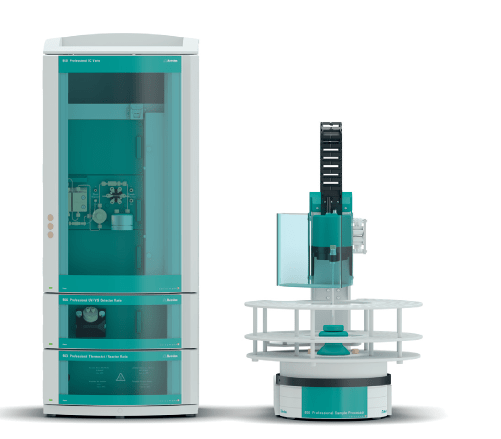
Figure 1: Ion Chromatography system components
Sampling
During method development and application, Samples were collected from tap water from various cities and contaminated sites in state of Oklahoma, State of Florida, State of Texas and State of California. It was observed that these samples contained high total hardness (as CaCO3), high levels of anionic species like chloride and sulfate, free chlorine (disinfectant) and other treatment chemicals. All samples and standards were prepared and preserved as per Section 8 of U.S. EPA method 218.7.
Analysis
After separation on an anion-exchange column, Cr (VI) is derivatized with 1,5-diphenylcarbazide in a postcolumn reaction. The generated magenta-colored chromium-diphenylcarbazone complex is detected by a UV/VIS detector at 530 nm.
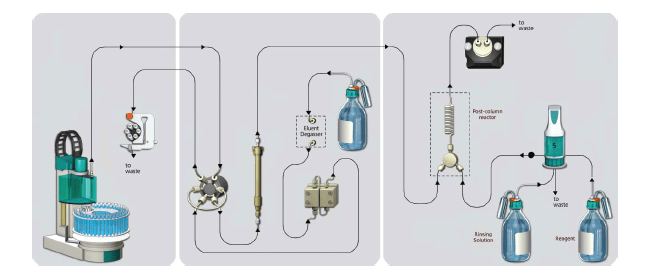
Figure 2: IC analysis system connection scheme
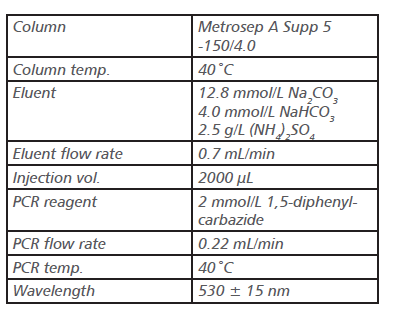
Table 2: Method analysis parameters
Instrument settings and method parameters have been optimized in terms of separation column, column oven temperature, wavelength, and flow rates
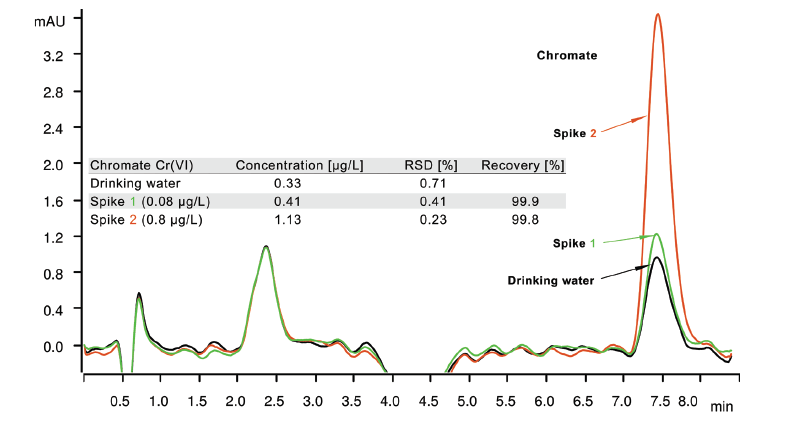
Figure 3: Typical Cr (VI) chromatogram, drinking water
Calibration and Linearity
The calibration curve utilized in the method was comprised of 8 individual low concentration Cr (VI) standard solutions.

The obtained calibration curve is linear over the entire concentration range with a correlation coefficient of 0.999994 and a relative standard deviation value of 0.595%.
Influence of Chloride and Sulfate
Influence of standard anions like chloride and sulfate on chromate is studied in detail. Analyses were carried out with 0-200 mg/L of chloride and sulfate added to the tap water sample spiked with 0.2 μg/L chromate standard. The optimized chromatographic method can provide recoveries between 90 to 110% for anion concentrations up to 150 mg/L.
Eluent – PCR Reagent Relationship
It is important to maintain exact ratio of eluent to post column reagent in PCR cell to ensure exact color formation for Cr (VI)-DPC complex. With the control of reagent delivery using the integrated Metrohm DosinoTM unit, precise and accurate PCR dosing was achieved, thereby ensuring the ruggedness of the method.
Method Detection Limit (MDL)
The method detection limit was calculated from the resulting standard deviation of seven replicates of reagent water fortified with two Cr(VI) concentration levels in the ppt range. For 0.025 μg/L and 0.05 μg/L Cr(VI) spikes, the determined MDLs were 0.007 μg/L and 0.016 μg/L respectively. These values meet the requirements of EPA, and prove that the method is suitable for routine analysis.
Lowest Concentration Minimum Reporting Limit (LCMRL)
EPA has developed a user-friendly and freely available downloadable software for deter-mining singlelaboratory lowest concentration minimum reporting levels (LCMRLs).
The LCMRL is defined as the lowest spiking concentration such that the probability of spike recovery in the 50% to 150% range is at least 99%. Unlike the MDL, which only considers the standard deviation of repeated measurements of low-level spikes, the LCMRL additionally includes the accuracy of the measurement.
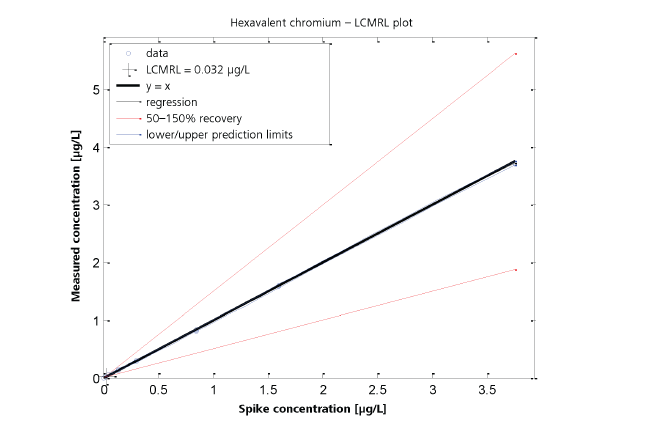
Figure 4: LCMRL plot for Cr (VI).
According to LCMRL calculations, it is determined that, a lab or analyst must be able to quantitate at least one half value of software calculated LCMRL.
In this study, the software calculated LCMRL is 0.032 ug/L. Furthermore, one of the calibration standards is set at 0.025 ug/L.
Conclusion
The release of the readily water soluble hexavalent chromium into the environment is a global problem that effects millions of people, and is especially paramount when it comes to sources for drinking water. In this context, extremely sensitive measuring methods are required to detect trace level Cr (VI) content.
The above mentioned application describes a precise, accurate and reliable analytical platform for trace level Cr (VI) analysis, fully compliant to U.S. EPA Method 218.7.
Metrohm Ion Chromatography Systems can offer a wide variety of options ranging from entry level routine instruments, all the way to highly automated modular platforms for research and method development. We are able to provide unique solutions that combine intuitive operation and excellent reliability with maximum flexibility to cater to all requirements for research and quality control laboratories in the water/environmental sectors and beyond.

References
1- U.S. EPA Method 218.7, Determination of Hexavalent Chromium by IC-UV/PCR
2- Metrohm Application Work AW IC US6-0152-012011 Determination of Hexavalent Chromium (Cr+6) in drinking
water, ground water and surface water by Ion Chromatography followed by Post Column Reaction (PCR) and UV/Vis
detection (conforming to U.S. EPA method 218.7)
3- Metrohm Information 1195794_MI_2012_EN Determine hexavalent chromium according to EPA Method 218.7

Furkan Özçil
Ion Chromatography
Product Manager
Metrohm Turkey





